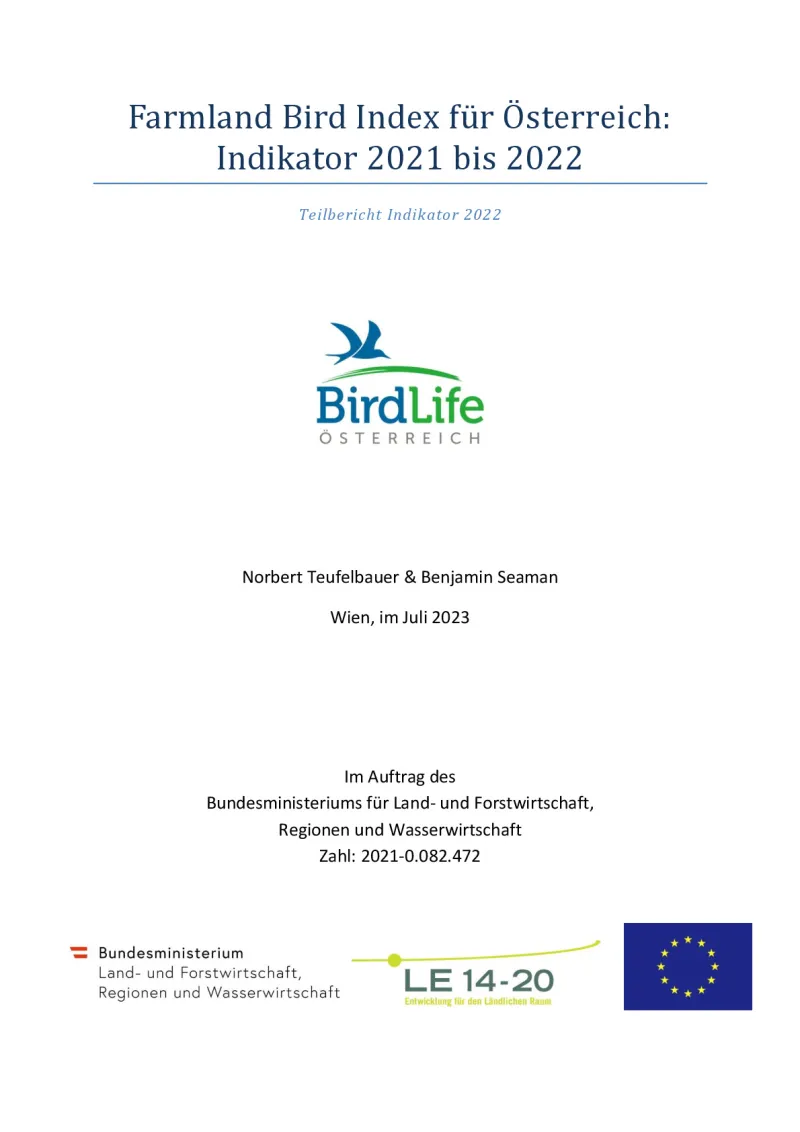Farmland Bird Index for Austria: Annual Report 2022
The research study should support the evaluation of the RDP Priority 4: Ecosystems related to agriculture and forestry.
- Austria
- 2014-2022
- Environmental impacts


The Farmland Bird Index (FBI) is a common impact indicator (I.08) for rural development. It was first used in the 2007-2013 RDP and is also used in the 2014-2020 RDP, including the extension years 2021 and 2022. The FBI is being monitored as part of a long-term study and is not an evaluation directly related to the implementation of the RDP. The Farmland Bird Index is made up of the population trends of typical bird species that are predominantly found in farmland, whereby various habitats within the farmland are mapped using the requirements of the selected bird species. The data basis for the Austrian Farmland Bird Index is the ‘Monitoring of Austria's Breeding Birds’, a population survey programme for common bird species that is carried out by BirdLife Austria and relies mainly on the cooperation of volunteers (‘Citizen Science’).
This observation programme has been running since 1998 and the surveys are standardised according to a precisely defined method. The bird observation data are collected by volunteers nowadays with the help of the app “NaturaList”. The annual count results can be used to calculate population trends for all bird species recorded in sufficient numbers. In a second step, the Farmland Bird Index is calculated from a selection of common bird species in the cultivated landscape. Population changes are calculated for 23 indicator bird species. The TRIM software and the MS Access tool BirdSTATs were used for the calculation. In terms of sample sizes, the data basis for 2022 was the third best in the history of the bird monitoring. It is likely that the COVID-19 pandemic was a major reason for the high sample sizes in 2020 and 2021. The cooperation of volunteers in the observation programme is crucial for the collection of good data. These volunteers are recruited through targeted advertising, and ‘old’ employees are motivated to continue their involvement. All counters and new people interested in the in the observation programme were supported on an ongoing basis (enquiries by phone and email, queries about the data collected, etc.). Selected employees were specifically approached and motivated to continue working on their counting routes. For the year 2022 the FBI was calculated at 52.6 per cent. According to the FBI short-term trend (2021/22), population declines dominate in comparison with the previous year: 20 of the 23 indicator species (87 %) showed a lower index value in 2022 than in 2021. Only three indicator species (13 %; kestrel, whitethroat and corn bunting) showed higher values in 2022 than in the previous year. The long-term trend 1998-2022 shows that the population of native field and meadow birds - as measured by 23 indicator bird species - is lower than ever before. The indicator has once again fallen significantly compared to the previous year and now stands at 52.6 per cent. According to the FBI, this means that 47.4 per cent of native farmland birds have disappeared since 1998. In the long-term trends, population declines predominate: 15 indicator species are declining in population, four show a stable population and four are increasing in population. A combination of long-term declines and an apparently poor breeding season for many indicator species in 2022 may explain the low value of the index.
Author(s)
Birdlife Austria, Norbert Teufelbauer and Benjamin Seaman